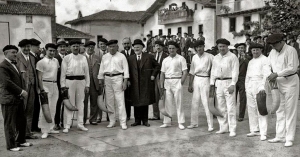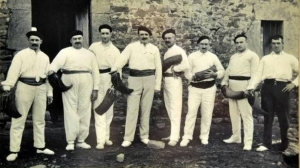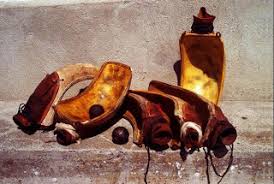Reflections on the cultural history of basque pelota, or the Basque ball game
- Kazuyuki Taketani. Professor at the University of Foreign Studies, Kobe, Japan. Anthropology and History of Sports.
- 09/ 12/ 2019
The author of this article, a professor at the University for Foreign Studies in the city of Kobe, Japan, proposes that folklore be analyzed as a globally interrelated concept, where a ball game, which serves as a connecting thread, shows the idiosyncrasies of traditional life. Our discussion here will not be solely limited to the province or territory of Bizkaia (Biscay), but it will be relate to that of the rest of the Basque Country or Euskal Herria.

Research into the history of tennis, can allow us to confirm its the origins, distribution, acceptation, and transformation, as described by many authors. Among European ball games, there is Perc, from the island of Goto (Sweden), Katsen (from Freesland), Tamblero (from Italy), etc., but there is, especially, the Basque pelota Basque ball game, the games originating from Euskal Herria, in their many modalities, and which are not found in other countries. Neither do we see the reasons for so many modalities, except for the fact that many variations of this form of Basque pelota can be found in other regions.
It is said that the roots of this rural sport is a desire to find entertainment, while being a display of Basque nationalism. But the Basques' complicated history impedes this matter from being completely clarified, and indicates that exchanges took place between Euskal Herria and other countries, or between different communities. A representative example of this would be the pilgrimage to Santiago de Compostela. Once pilgrims cross the French border in the Pyrenees, and the Basque Country appears on the way to the cathedral of Santiago de Compostela, they must cross Basque routes, long or short. In this way, the influence of pilgrims, their different cultures, and their different economies, have given rise to Basque sports.
In Basque and in Spanish history, in the struggle against outsiders and the Roman, Gothic, Frankish, Moorish cultures, etc. the peoples of the peninsula have been the recipients of several cultures from diverse civilizations. This means that cultural origins are diffuse or complex.
In the architectural and artistic world, we can confirm the "tracks" of different cultures, even though for the study of culture, historians lack traditional, written works. On December 30, 1992, Caro Baroja, at his farmhouse "Itxea", in Vera de Bidasoa, remarked to me: "Here, in Vera de Bidasoa, near the border, there has been cultural exchange-including economic exchange. It has influenced everything. That's why I am here". These words show that the Basque area has been accepted and has become culturally transformed.
In his book, Kuroda says, "traditional society is always changing. Strictly speaking, since I cannot use the word 'traditional', it is Caro Baroja who would think of 'tradition in general, and transformation" . This illustrates his dynamic point of view regarding Basque society. The opinion that "the Basques are the curators of tradition" is in part correct, but it is unilateral and must therefore be amended. Basque society is changing gradually; in other words, it does not need to change, except in the cities.
Meanwhile, foreigners who are unfamiliar with the situation believe that Basques should live as they did in the past. The same is true for the world of sports culture. If we accept the idea that traditional, ancestral sports have not changed at all, we cannot think about studying anything, as Bobsbom, an English researcher, said in 1992. Basque culture has received many others, influencing and contributing to cultural conservation together with that of daily life and knowledge of its own value.
To confirm this idea, we just have to look at Basque sports. It is reasonable to see that, in Euskal Herria, many modalities of the old ball games have been preserved, which may be compared to other European ball games. The study of Basque sports is related to Basque originality. Laxoa is a modality that has been preserved in the north of Nafarroa, and is the oldest modality of Basque pelota. It is played in the valley of Baztán and in Maldaerreka; of course, this does not include the versions played in Valencia or the Canary Islands.
There are three types of direct balls: laxoa, paxaka, and rebound (lit. rebound). It is said that, among them, laxoa y paxaka are the oldest. While the rebound game is not older than the other two, using a short basket (joko-garbi), Laxoa is not an indirect game, as is handball, but it is played in a public square, in the center of the village. It has no central net, and only one line. Paxaka, as in the case of "real tennis" but "it is played on a court with a net. The difference between laxoa and paxaka is the existence of an "arraya" or "line", or "chaza." Laxoa does have one, but paxaka does not. Although both are old games, here we will not be dealing with paxaka, whose rules are simpler than those of laxoa.
Jeu de paume, the ancestor of tennis, and of the Euopean game of tennis, does have this line. There is an interrelation between culture and sports. Historical studies on tennis-type games give most importance to those played indoors. But we will be dealing here with the cultural history of those played outdoors, laxoa, and focusing on the rules regarding the line.
A brief history of laxoa
This game, both laxoa as well as bote luzea are similar, although in the latter, the hand is used. The word "laxoa" is Basque, and in Spanish it means "long game", or, in other words, France's longue paume, a modality of jeu de paume. Laxoa is pronounced as lashua among the "friends of the glove", or men of that area. Bombín Fernández and Bazas- Urrutia tell us that this type of pronunciation is the result of influence from outside Euskal Herria.

Its origins are, according to the Laxoa Association, a ball game played by shepherds on the mountain, soropil or pilota-soro. These shepherds came down to the farming villages and spread it throughout the region. Up to the end of the 19th century, it was most popular in the Basque Country. It was played in the north of Nafarroa, Gipuzkoa, in part of Bizkaia, and also in France. Its most famous player was Perkain, who appeared towards the end of the 18th century, or the start of the 19th. Since he was opposed to the ideas of the French Revolution, he fled the Baztán valley to the Baigorri valley, and took up residence in Aldudes. It is said that, he deserved to be on the first page of the history of laxoa for his fame and outstanding activity. Halfway through the 19th century, the game was at its most popular, with inter-village, inter-regional, and international matches. Everyone would attend a match, which would be played in Sunday afternoons. It is said that the most memorable laxoa match took place in Irun, between Guipuzkoa and France.
In 1870, the "ble" method appeared, where the ball is thrown against the wall, indirect playing, and laxoa began to lose its popularity, as this new modality became implanted among the pelotaris. However, in the valleys of Baztán and Maldaerreka, the previous modality of laxoa has survived, and coexists with the other. Although efforts are being made to keep it alive, young people prefer to play modern sports.

The rules of laxoa
There are five elements that make up the basic structure of laxoa: glove, ball, botillo, a public square, and the rules.
The glove: Gloves are either short or long, and weigh either 900 or 1100 grams. They are made of cowhide, and are curved, for their pitching action. The short glove is used to hit the ball, and the long glove is used for throwing. Pitching in laxoa is not similar to that of baseball, in that, once the ball has been picked up, in one sweeping curve, it is thrown again. This action is known as pick-up and pitch.
These characteristics are generally common in all handball-type sports, but it is hard to distinguish between the two. Two glove makers, Eusebio Arregui, of Doneztebe, and Frorentino Ybarra, of Labayen, live in Euskal Herria, but they have no one to follow in their footsteps.
The ball: In the primitive world, there were many types of balls, among them stuffed balls, woven balls, inflated, sculpted, wrapped, balls made in the shape of fruit, etc. In the Basque Country, a wrapped ball is used. It has a diameter of 65 mm, and weighs between 115 and 125 grams. Halfway through the 19th century, a larger ball was used (diameter 90mm), but at the beginning of the 20th century, rubber was introduced, and players now use the "wind ball".
Botillo or botarri is the pitching platform. Each village has its own botillo with a tripod. They used to be made of stone, or sometimes of wood, although they are no longer used, and few people are familiar with their use. The surface of the botarri it tipped to one side in order to allow for pitching, and they were adjustable in height.
Public square: The name for the mountain court was soropil or pilota-soro. In euskara, this means the place where ballgames are played. Mostly, it indicates an often irregular, grass court, which was marked by a dugout line, where the game was played without bouncing the ball, since bounce would be irregular. When they first came into being, the games did not use the botillo; it was a feature to be added on later, and was placed in a corner of the court.
The mountain soropil then shifted to the village, and was situated at an open public square, a practice still used today, taking advantage of one of the walls of the church. The ball was bounced off the wall, and thus, the wall also found its place in the rules.
Presently, the court can be a public square nearby the church. As Inagaki says, the square is a good place, because we imagine that is a holy place.
When the game is played in a public square, it is sometimes necessary to alter some of the rules in order to accommodate different conditions. For example, the floor is asphalted or cemented, and not covered with packed earth, as it would have been before. Also, not also public squares are exactly square-sides may be 60m or 100m, and the top or bottom may be 12m or 20m, and there are some that are actually rectangular. At one end of the square is the wall, which used to be short, but which is now long, since the appearance of the "ble". The villagers' homes are around the square and the walls of the church or of these houses would also be used. Although 40 years ago, there was a town square, and the construction of the wall and of the house, they would have reduced the numbers.
Raya, arraya, chaza: In French "chasse", in Italian, "caccia", in Portuguese, "caca ". In the treasure of Covarrubias, we may confirm the fact that "chaza" means the line or lines that we are now familiar with. And in English, the "chase" is the second bounce of the ball.
In a laxoa match, the court is first divided evenly in half. Later, each team chooses its part of the court. When the raya variation is played, it is according to how clear the court is, or ho irregular it is in shape. Gillmeister, a German researcher, describes in his book how raya was played in the Middle Ages, using that of Zaterland as an example. Its rules are the same. Scaino's book, written in 1555, says the same thing. Also, Mediaeval ball games all conserved the same raya rules. Thus, laxoa follows the modality of the Middle Ages, and it is possible that this game is similar to the European ball game of that time.
Structure and physical movements in raya
Until the field is divided, it belongs to both teams equally. But, once the raya has been set, after changing sides of the court, one team has an advantage over the other, and vice-versa. What does this mean? People say that playing the raya is the main objective in this game-its true charm. In the valley of Baztan and Maldaerreka, they do not know its precise meaning. Let us analyze this problem, based on existing historical bibliography. Scaino, in his book, given to the king in 1555, says that tennis games come to a raya when:
"They continue playing until the server or the others fail to propel the ball or until the ball hits the ground on one of the sides. Where the ball stops, a mark is made on the raya, or line. This is equivalent to "the mark of the ball that has been hit". Generally, a raya is called when the ball hits, but does not pass, the restricted line inside the court and without being hit. In other words, when either occurs, raya is not called-but an extra point is scored".
When "raya" is played, after a change of sides, "consigue tanto cuando acercan una raya marcada a otro equipo". This means that it is valid to throw the ball behind the line. In the 16th century, there was no difference between indoor and outdoor matches. It was the match played "without limiting lines" using a public square. Only a center line was marked. In the meantime, in indoor matches, the court was clearly divided by a net, a very complicated structure with a gallery, a small roof, "grille", etc. that influenced in extra points, inside the court, there was an assistant, as in any Basque pelota match. Outdoor matches had simpler rules, similar to those of laxoa.
Regarding jeu de paume, we have the opinion of Darmanue, from the start of the 20th century:
"A team hitting the ball from one side of the court hits it as far as possible. The other tries to make it go back to close by the serve area. If they do not hit the ball before it falls, or after it bounces, the game is interrupted. The ball must always be hit from the same place".
The outdoor version of the game of jeu de paume has a similar rule, the only difference being in the existence of the walls. Raya is the second bounce, but there is no line for the raya. This game is laxoa, to be exact. It is only missing a raya line. This book was published in 1901, when there were many ball games with or without raya lines.
Gillmeister indicates that this raya symbolizes the breaking down of the gate to the fort. Particularly in the case of the earlier versions of the game, which were won when the ball was hit and landed in the tambor or gallery.
This modality would be the prototype of the football field, and the pas d'armes of the chivalric games during the Middle Ages. Continuing with this idea, these games are similar as the ball had to pass a specific line. This has changed over the centuries, but I do not have space to deal with this here. The rule that a court is divided in half would be a question of debating the right of ownership in a wider field. The games of raya involve one team attacking the territory of the other team.
Conclusion
I have looked at the historic structure of laxoa in terma of the "raya". I have confirmed that laxoa raya exists, that have evolved from the medieval games to tennis and that "raya" is still played in Euskal Herria. This can be confirmed by books from the 16th century. However, the method of playing pelota can not be found in the Pyrenees. Furthermore, emphasis has been placed on there having been "raya" prior to the game of breaking down the medieval fort by Gillmeister and there is therefore at least the verification of the game of "raya" and its relationship with the breaking down.
In the history of Basque pelota, it is said that the game comes from shepherds. The reason shepherds played ball in the mountains would be that it is a useful technique in shepherding the flock of sheep. Even though the technique is well-known in the history of pelota, no details have been discuseed.
The origins of Basque pelota would be Pyrenees sun-worshipping cultures, or a game after a ritual, passed down through the ages. In other words, it is a pre-Christian shepherd game.
The eyewitness accounts of three Basque laxoa participants, two players and a spectator, implicate that young men from mountain farms used to gather in a common grassy area to play laxoa. In other words, it seem that there were two types: that played in the mountains, and that played in the villages. A field used by shepherds would have been close to town, where it was easy to get together, and thus, the game gradually shifted to the town itself. This phenomenon is also related to the decline of shepherding and a transformation in lifestyle.
The Pyrenees Basque pelota courts still exist, this means that shepherds played Basque pelota. However, we can not identify the step to laxoa.
Acknowledgements
This article was written with the help of Jose Iraundegui and Josean Iraundegui, from FIPV, and Tiburcio Arrastoa, of Amigos del Guante.
Bibliography
Abril , E., (1971), Dos siglos de pelota Basque, Madrid.
Aguirre Franco, R., (1979), Enciclopedia general ilustrada del País Vasco, sports and games, Auñamendi, San Sebastian.
Aguirre Franco, R.,(1983) , Gure Herria, sports and games of the Basque Country, Kriselu, Donostia.
Allaux , J-P., (1993), La pelote basque de la paume au gant , J&D ediciones.
Baradiarán, J.M.,(1978), Euskaldunak Etor , San Sebastian.
Blazy , E., (1929) , La pelote basque , Bayonne , Pialloux.
Fernández , L.B. y Bozas-Urrutia ,(1976) , El gran libro de la pelota , Deporte universal (2 tomos) , Madrid.
Caro Baroja , J., (1971) , Los Basques , Ediciones Istmo, S.A., Madrid.
Editorial team of "Kirolak-Lur", (1990), Nosotros los Basques, Lur Agritaletxea.
Gillmeister , H., (1990) , Kulturgeshichite des Tennis , Wilhelm Fink Verlag , München.
Inagaki, M., (1997), La relación entre el origen de los juegos de tenis y los de pelota from Los estudios de la Historia de Deporte #10 , La Society de la Historia de Deporte.
Landa , X., (1991) , "Pelotari su entorno" , Xabier Landa , Pamplona.
Llopis Bauset, F., (1987), El joc de pilota, Ed., Valencia City Council, Valencia.
Luze , A.,de ,(1933) , La magnifique historie du jeu de paume , Bordeaux: Delmas , Paris: Bossard.
Moreno Palos , C., (1992) , Juegos y deportes tradicionales en España , Alianza Deporte , Madrid.
Ollaquindia , R., (1982) , El juego de pelota en Navarra , Cuadernos de Etnología y Etnografía de Navarra , 14 , #39 , Institución Príncipe de Viana , Pamplona.
Omote , T., (1997) , En busca del origen de tenis , Taisyukan Syoten , Tokio.
Pena y Goni, A., (1988), La pelota y los pelotaris, Editorial Amigos del Libro Vasco, first edition, 1892.
Scaino , A., (1555) , Trattato del Guioco della Palla , Venice.
Taketani , K., (1987) , Estudio sobre las modalidades de la pelota Basque , Kobegaidaironso , Vol.38 , #5 , Kobe.
Taketani , K., (1997) , Estudios de los juegos de tenis y pelota Basque desde los documentos del año 1331 , Kobegaidaironso , Vol. 48 , No.4 , Kobe
Tudela de la Orden , (1969) , El juego de ambos mundos , Citius Altus Fortius , t.? , booklets 3-4, published by Ed. INEF, Madrid.
Tujimoto , Y., (1998) , El reglamentos de los juegos del paume francés en el siglo 16 , Kobesyoinjyogakuindaigaku y Kobesyoinjyogakuintankidaigaku , #39 , Kobe.
Villareal , P., de , (1984) , Etnografía Baztanesa Retazos , Cuadernos de Etnología y Etnografía de Navarra , 16 , #43 , Institución Príncipe de Viana , Pamplona.







